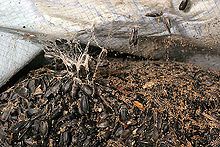- Indianmeal Moth
-
Indianmeal Moth 
Scientific classification Kingdom: Animalia Phylum: Arthropoda Class: Insecta Order: Lepidoptera Division: Ditrysia Family: Pyralidae Tribe: Phycitini Genus: Plodia
Guenée, 1845Species: P. interpunctella Binomial name Plodia interpunctella
(Hübner, [1813])Synonyms Many, see text
The Indian Meal Moth (Plodia interpunctella), alternatively spelled Indianmeal Moth, is a pyraloid moth of the family Pyralidae. Alternative common names are North American High-flyer and Pantry Moth; less specifically, it may be referred to as "flour moth". The Almond Moth (Cadra cautella) is commonly confused with the Indianmeal Moth.
Its larvae (caterpillars) are commonly known as "waxworms" like those of its relatives, though they are not the particular waxworms often bred as animal food. They are a common grain-feeding pest found around the world, feeding on cereals and similar products.
Contents
Systematics and etymology
This is – as far as is known – the only living species of the genus Plodia. It is closely related to the (doubtfully distinct) genera Cadra and Ephestia which include(s) other pest species (e.g. E. kuehniella which is also colloquially called "flour moth").[1]
The species has been described under a number of junior synonyms, which may occasionally still be found in non-entomological sources:[2]
- Ephestia glycinivora Matsumura, 1917
- Ephestia glycinivorella Matsumura, 1932 (unjustified emendation)
- Plodia castaneella (Reutti, 1898)
- Plodia glycinivora (Matsumura, 1917)
- Plodia interpunctalis (Hübner, 1825)
- Plodia latercula (Hampson, 1901)
- Plodia zeae (Fitch, 1856)
- Tinea castaneella Reutti, 1898
- Tinea interpunctalis Hübner, 1825
- Tinea interpunctella Hübner, [1813]
- Tinea zeae Fitch, 1856
- Unadilla latercula Hampson, 1901
The common name for this species was coined by Asa Fitch, an entomologist employed by the state of New York during the nineteenth century. In a report published in 1856, Fitch discussed the species, noting that the larvae infest stores of cornmeal, which was then called "Indian meal". [3]
Description and life cycle
Adults are 8–10 mm in length with 16–20 mm wingspans. The outer half of their forewings are bronze, copper, or dark gray in color, while the upper half are yellowish-gray, with a dark band at the intersection between the two. The moth larvae are off-white with brown heads. When these larvae mature, they are usually about 12 mm long.[4]
The entire life cycle of this species may take 30 to 300 days. Female moths lay between 60 and 400 eggs on a food surface, which are ordinarily smaller than 0.5 mm and not sticky. The eggs hatch in 2 to 14 days. The larval stage lasts from 2 to 41 weeks, depending on the temperature.[4]
-
Larva on sprinkles
Pest status and pest control
 Damage to sunflower seeds
Damage to sunflower seeds
The Indianmeal Moth larvae can infest a wide range of dry foodstuffs of vegetable origin, such as cereal, bread, pasta, rice, spices or dried fruits and nuts. More unusual recorded foods include chocolate and cocoa beans, coffee substitute, cookies, flour, dried mangelwurzel, and even the toxic seeds of Jimsonweed (Datura stramonium). The food they infest will often seem to be webbed together.[5]
After larvae or moths have been found, it is important to throw out all food sources that are not in very tightly sealed containers. The moths are able to get into surprisingly tight spots, including sealed bags and Tupperware containers. They are also notoriously difficult to get rid of, and can crawl on ceilings and spin cocoons in rooms other than the kitchen or pantry where they hatched. Last instar larvae are able to travel significant distances before they pupate. When seeking the source of an infestation, the search thus cannot be limited to the immediate area where pupae are discovered.[6]
Nontoxic traps are also available to inhibit the development of adult moths and precipitate their destruction. For example, one type of trap is a triangular box with a lure inside and sticky walls. These traps are generally known as pheromone traps. In this case male moths are attracted inside by the female pheromone (the lure) and then get stuck against the sticky walls inside of the box.[7]
Moths often do not even need a lure, as common glue traps sometimes work well to reduce the number of adults.[citation needed]
The caterpillars are parasitized by Bracon hebetor, a braconid wasp which is a potential biological control agent.[8]
Footnotes
References
- Fasulo, Thomas R. & Knox, Marie A. (2009): University of Florida Featured Creatures – Indianmeal moth, Plodia interpunctella Hübner. Version of December 2009.
- Fitch, Asa (1856): First and Second Report on the Noxious, Beneficial and other Insects of the State of New York. C. Van Benthuysen, Albany, USA. Fulltext at Internet Archive
- Grabe, Albert (1942): Eigenartige Geschmacksrichtungen bei Kleinschmetterlingsraupen ["Strange tastes among micromoth caterpillars"]. Zeitschrift des Wiener Entomologen-Vereins 27: 105-109 [in German]. PDF fulltext
- Horak, Marianne (1994): A Review of Cadra Walker in Australia: Five New Native Species and the Two Introduced Pest Species (Lepidoptera: Pyralidae: Phycitinae). Austr. J. Entomol. 33(3): 245–262. doi:10.1111/j.1440-6055.1994.tb01226.x PDF fulltext
- Klass, Carolyn (2009): Pesticide Management Education Program – Indian Meal Moth. Version of February 2009. PDF fulltext
- Lyon, William F. (2006): Ohio State University Insect and Pest Fact Sheets – HYG-2089-97: Indianmeal Moth. Version of 2006-AUG-31.
- Phillips, Tom (1995): Biological Control of Stored-Product Pests. Midwest Biological Control News Online 2(10). HTML fulltext
- Savela, Markku (2009): Markku Savela's Lepidoptera and some other life forms – Plodia. Version of 2009-APR-09. Retrieved 2010-APR-10.
External links
- Fact sheet on Indian Meal Moths featuring information on habits, habitat and pictures
- Pantry Pests, University of Nebraska-Lincoln Extension in Lancaster County
- Scarabogram Bug of the Month: Indianmeal Moth
- Home and Garden: Indianmeal Moth
- OzAnimals - Indianmeal Moth
- University of California Integrated Pest Management: – Pantry Pests
- Ladd Research: Indian Meal Moth – Identification
- Get Rid of Things: How to Get Rid of Moths
Categories:- Phycitinae
- Household pest insects
- Animals described in 1813
Wikimedia Foundation. 2010.





